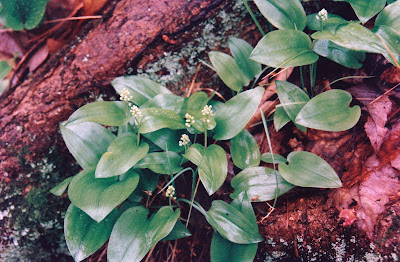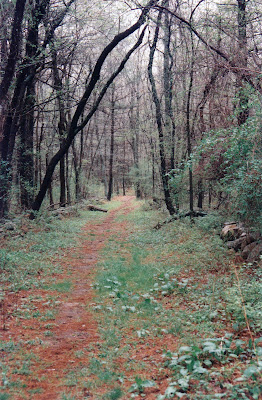 |
| Spring ephemerals. |
April showers bring may flowers . . . and starflowers, trillium, goldthread and lady slippers . . . and so much more. In May, when many of our woodland wildflowers are in bloom, a walk in the forest becomes a stroll through the most natural of gardens. But you have to know where to look.
Norwell’s Stetson Meadows is an ideal place to see woodland wildflowers in bloom. This 144-acre parcel, accessible from Stetson Shrine Lane, includes a network of trails that lead through pine forests and woody swamps, offering views of both the North River and its tidal marshes.
Follow the River Trail through this town-owned conservation land and you will see honeysuckle, solomon’s seal, and partridge berry, as well as all of the species mentioned above. Better still, you can treat yourself to a guided tour. Thanks to local wildflower expert Winnie Lou Rounds, the River and Twin Pines Trails now feature identification tags declaring the English and Latin names of otherwise easy-to-overlook flowers and shrubs.
Earlier this month I joined Winnie Lou, her husband Chuck (an expert on ferns), and a small group of fellow nature enthusiasts for an exploration of Stetson Meadows. It was an overcast morning, but the woods were alive with color, as if, as Winnie Lou described it, “someone had taken a paintbrush and made it all green.”
We headed down the River Trail, past blooming apples trees and into a pine forest, pausing every ten feet or so to study the many flowering species in residence there. At first, it all looked the same to me — just one green plant after another — but with our leaders’ help, I was soon able to distinguish the pepper bush from the blueberry, and the starflower from the windflower. What were once simply ferns to me became hay-scented, cinnamon, and Christmas varieties. The species I once classified simply as princess pine became distinctly different members of the lycopodium family — the staghorn, candelabra, and running pine tree-club mosses.
 |
| Stetson Meadows in the Spring. |
One could spend months on end studying the intricacies of these delicate woodland flowers, but because their blooming season is so short, one or two weeks each year must suffice. Also known as Spring Ephemerals, these wildflowers are true to their name, lasting in most cases only a few days. You must catch them as you can. For our walk, the yellow flowers of the bellwort and clintonia borealis were blooming, and the tiny white canada mayflowers, the pinkish wood anemone, and the oddly-shaped indian pipe were soon to follow.
I don’t pretend to know a lot about wildflowers — or trees, shrubs, or mosses for that matter. I am by no means a naturalist, only a lover of nature. But even this brief introduction to a handful of native species made me feel more connected to this part of the world that I call home. I liken it to learning the names and faces of other people in town: with each introduction, with each new face I recognize at the bank or in the grocery store, I become more invested in — and more attached to — my community. With each new species of wildflower, fern, and shrub that I am able identify, my appreciation and respect for the forests, meadows, and marshes around me increases in kind.
The River Trail intersected with the Twin Pines Trail, which eventually brought us back to the main road, where the green waxy leaves and red berries of wintergreen were in abundance. We continued on Twin Pine, encountering some towering white pines. These centuries-old trees, so large that most would be unable to wrap their arms around them, are a rarity on the banks of the North River, where in times past nearly all the vegetation was cleared either for agriculture or shipbuilding.
Twin Pine led directly to Stetson Meadows’ newest addition, the EMS Trail, named for the sporting goods outlet that funded its creation on last year’s National Trails Day. The EMS Trail took us through a small hemlock grove, and showed us our first lady slipper of the day, not yet in bloom. The occasional crumbling stone wall and a number of moss-covered logs made the scene especially picturesque.
The highlight of the walk came at the end, when we detoured down an old cart path, crossed a small stream, and followed a wide trail to the wildflower that our leader was most excited to share with us. We had to step carefully around a patch of poison ivy, but our efforts were rewarded with a close-up view of the drooping white petals of the nodding trillium, a rare find in these woods.
Stetson Meadows Conservation Area, known to some as “the Norris Reservation’s wilder cousin,” is located at the end of Stetson Shrine Lane, off River Street, in Norwell. Some parking is available at the cul de sac at the end of the paved road, but it is best to continue 0.7 miles down the rutted dirt road, past the historic Stetson Ford house, to the newer parking area, just across from the head of the River Trail.
Stetson Meadows includes six trails, some better marked than others. For a good introduction to the property, follow the River Trail through the Witchy Woods pine grove to a rise overlooking the marshes of the North River. Looking out over the water from at this former indian camp, you will have an idea of what the river was like fifty years ago, before houses were built up and down its banks. Picnic tables and a wooden bench make this an ideal spot for lunch or contemplation.
Continue from there on the Twin Pines Trail. If you keep your eyes cast downward along the way, you will see the handwritten tags identifying wildflowers and shrubs at either side of the path. Eventually you will return to the main road. Turn left, and follow the road back to the parking area.
by Kezia Bacon, Special To The Mariner
May, 1998
Kezia Bacon’s articles are provided by the North and South Rivers Watershed Association.

